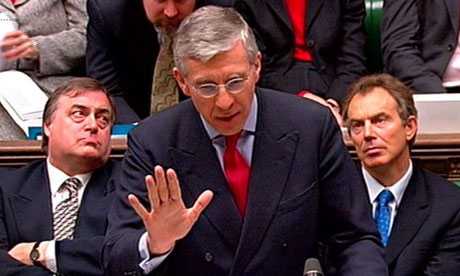Tory MP and defence specialist Adam Holloway says MI6 got information from a taxi driver who had heard Iraqi military commanders talking about weapons

An Iraqi taxi driver was the source of the discredited claim that Saddam Hussein could unleash weapons of mass destruction within 45 minutes, a Tory MP claimed today.
Adam Holloway, a defence specialist, said MI6 obtained the information indirectly from a taxi driver who had overheard two Iraqi militarycommanders talking about Saddam’s weapons.
The 45-minute claim was a key feature of the dossier about Iraq‘s weapons of mass destruction that was released by Tony Blair in September 2002. Blair published the information to bolster public support for war.
After the war the dossier became hugely controversial when it became clear that some of the information it contained was not true. An inquiry headed by Lord Butler into the use of intelligence in the run-up to the war revealed that MI6 had subsequently accepted that some of its Iraqi sources were unreliable, but his report did not identify who they were.
Today, in an interview with the Daily Mail, Holloway said the key piece of information about 45 minutes came from an Iraqi officer who was using a taxi driver as his own sub-source.
“[MI6] were running a senior Iraqi army officer who had a source of his own, a cab driver on the Iraqi-Jordanian border,” said Holloway, a former Grenadier Guardsman and television journalist.
“He apparently overheard two Iraqi army officers two years before who had spoken about weapons with the range to hit targets elsewhere in the Middle East.”
Holloway made his comments to coincide with the publication of a report he has written claiming that MI6 always had reservations about some of the information in the dossier but that these reservations were brushed aside when Downing Street was preparing it for publication.
According to the Mail, Holloway says in his report: “Under pressure from Downing Street to find anything to back up the WMD case, [MI6] were squeezing their agents in Iraq for anything at all.
“In the [MI6] analysts’ footnote to their report, it flagged up that part of the report describing some missiles that the Iraqi government allegedly possessed was demonstrably untrue. The missiles verifiably did not exist.
“The footnote said it in black and white. Despite this the report was treated as reliable and went on to become one of the central planks of the dodgy dossier.”
Holloway claims that MI6 was not to blame for the fact that the footnote was ignored. “It seems that someone, perhaps in Downing Street, found it rather inconvenient and ignored it lest it interfere with our reasons for going to war,” his report says.
The report is due to be published on the first defence website.
Butler concluded that, although the claims in the Iraq dossier went to the “outer limits” of what the intelligence available at the time would sustain, there was no evidence of “deliberate distortion”.
Today Sir John Scarlett, the key figure responsible for the preparation of the dossier, will give evidence to the Iraq inquiry. Scarlett was chairman of the joint intelligence committee at the time and he went on to become head of MI6.
He is expected to be asked about the dossier, although he is unlikely to provide detailed information about MI6 sources in public. The inquiry has said that, if witnesses want to discuss confidential issues relating to national security, they can do so in private.
The September dossier did not specify what weapons Iraq could deploy within 45 minutes. Intelligence officials subsequently revealed that it was meant to be a reference to battlefield weapons, not long-range missiles.
But, when it was published, some British papers interpreted the dossier as meaning that British troops based in Cyprus would be vulnerable to an Iraqi attack. At the time the government did not do anything to correct this error.
Guardian

Leave a Reply